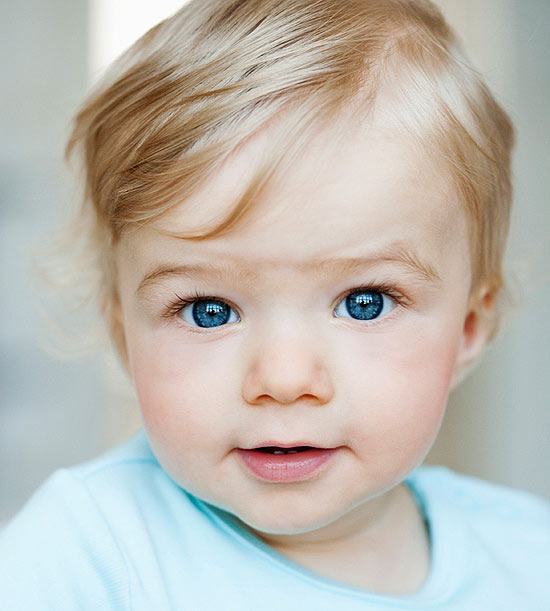
After leaving the comforts of a warm, dark womb, your baby's initial look at the real world is bright and a bit confusing. "His eyes have never been exposed to light before, so his brain has to learn how to interpret the signals the eyes send to it," says David Rogers, M.D., director of Pediatric Eye Research at Nationwide Children's Hospital, in Columbus, Ohio. And that's just the beginning. From recognizing familiar faces to developing hand-eye coordination, a baby's eyes come a long way during the first 12 months. Take a look at the different stages of your little one's vision development and how you can help him through each one.
Newborn
Even at birth, a baby can see 20/400, or about 8 to 10 inches away, which is equivalent to the distance between your face and his when you cradle him, says Golareh Fazilat, M.D., a pediatric ophthalmologist at Children's Eye Center of Orange County, in Irvine, California. While babies' eyes are able to focus at farther distances, the other parts of the visual system, including the brain and retina, haven't matured enough to process stimuli that is past that point.
How to help Go ahead and coo, cuddle, and lock eyes. A newborn will have no problem seeing your face and expressions, so use these couple of weeks to get extra close.
2 to 8 weeks
Though your baby will be spending lots of time dozing, she'll experience a steady development in her vision whether she's awake or fast asleep. Her ability to focus, interpret color, and distinguish between shades of contrast will rapidly improve in the first month. However, it's perfectly normal if her eyes aren't quite tracking together yet, says Dr. Rogers. Many infants' eyes wander or do not stay aligned with each other during the first few months of life because their eye muscles are still developing and learning how to work together.
How to help Feed your baby on alternating sides to give both of her eyes a chance to mature. Whether you are using the breast or bottle, mealtime is an opportunity for her to exercise and develop her eye muscles as she stares up at you.
2 to 5 months
Your baby's world has gotten a lot less blurry, and his vision will generally improve to 20/60. What does this mean exactly? "Studies have shown that a 4-month-old can see objects the same size as the 20/60 line on the eye chart. If your child was sitting 20 feet away from the eye chart, an adult with normal vision would see something the same size while standing 60 feet way," explains Dr. Rogers. At this age, he should also be able to track an object that moves from side to side. Test this by sitting face to face with your munchkin in his car seat or bouncy chair and moving left to right in his field of vision. The goal is for him to keep his eyes focused on your face throughout the exercise.
How to help Give your baby a variety of visual stimuli. Consider switching out toys on the mobile or handing him a new book or game to play with once a week. And be sure to keep your well visits with the pediatrician, recommends Zoey Goore, M.D., a Kaiser Permanente pediatrician in Roseville, California. Let your doctor know if you notice any red flags, such as if your baby doesn't seem interested in high-contrast toys or images, doesn't react to bright lights, or has eyes that appear cloudy or are not straight or tracking together.
6 to 12 months
By just 6 months, your baby can see 20/30, or in other words, almost as well as you. She will be able to distinguish a wide range of colors and levels of contrast, focus at a variety of distances, and follow objects with her eyes, says Dr. Goore. As she gains mobility and begins crawling, and eventually walking, her eyes will become vital for depth perception and help enhance her coordination and balance. You may also notice that your baby's eye color is darkening during these months — and that's completely normal. While some babies are born with dark eyes that will get even darker over time, infants of many ethnicities are born with blue or lighter eyes because the darker pigments in the iris have not completely developed yet, says Dr. Fazilat. But by 6 to 8 months, her permanent color should begin coming through.
How to help Offer her stacking blocks or roll a ball back and forth with her, both of which foster hand-eye coordination. The ability to focus, interpret color, and distinguish between shades of contrast will rapidly improve in the first month.
Originally published in the January 2015 issue of Parents magazine.
All content on this Web site, including medical opinion and any other health-related information, is for informational purposes only and should not be considered to be a specific diagnosis or treatment plan for any individual situation. Use of this site and the information contained herein does not create a doctor-patient relationship. Always seek the direct advice of your own doctor in connection with any questions or issues you may have regarding your own health or the health of others.
Parents Magazine

